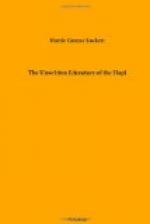From those who know most of Indian sacred and decorative symbols, we learn that two main ideas are outstanding: desire for rain and belief in the unity of all life. Charms or prayers against drought take the form of clouds, lightning, rain, etc., and those for fertility are expressed by leaves, flowers, seed pods, while fantastic birds and feathers accompany these to carry the prayers. It may be admitted that the modern craftsman is often enough ignorant of the full early significance of the motifs used, but she goes on using them because they express her idea of beauty and because she knows that always they have been used to express belief in an animate universe and with the hope of influencing the unseen powers by such recognition in art.
The modern craftsman may even tell you that the once meaningful symbols mean nothing now, and this may be true, but the medicine men and the old people still hold the traditional symbols sacred, and this reply may be the only short and polite way of evading the troublesome stranger to whom any real explanation would be difficult and who would quite likely run away in the middle of the patient explanation to look at something else. Only those whose friendship and understanding have been tested will be likely to be told of that which is sacred lore. However, if the tourist insists upon having a story with his basket or pottery and the seller realizes that it’s a story or no sale, he will glibly supply a story, be he Indian or white, both story and basket being made for tourist consumption.
To the old time Indian everything had a being or spirit of its own, and there was an actual feeling of sympathy for the basket or pot that passed into the hands of unsympathetic foreigners, especially if the object were ceremonial. The old pottery maker never speaks in a loud tone while firing her ware and often sings softly for fear the new being or spirit of the pot will become agitated and break the pot in trying to escape. Nampeo, the venerable Tewa potter, is said to talk to the spirits of her pots while firing them, adjuring them to be docile and not break her handiwork by trying to escape. But making things to sell is different—how could it be otherwise?
In one generation Indian craftsmen have come to be of two classes, those who make quantities of stuff for sale and those few who become real artists, ambitious to save from oblivion the significance and idealism of the old art that was done for the glory of the gods. Indian art may survive with proper encouragement, but it must come now; after a while will be too late.




